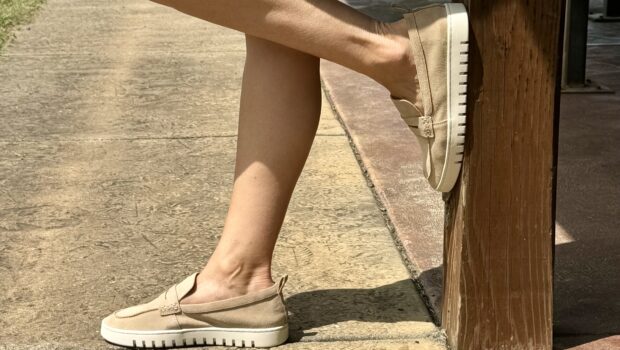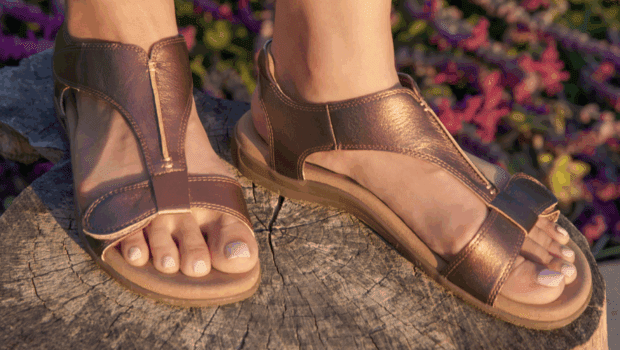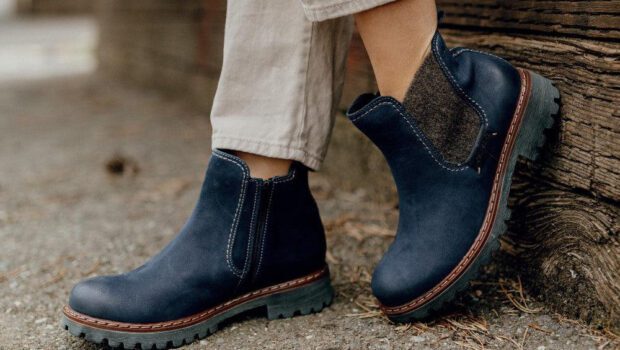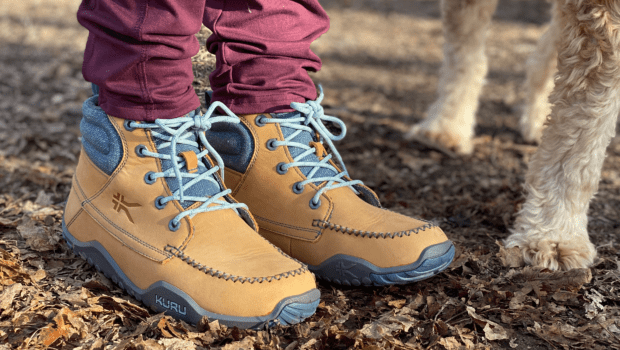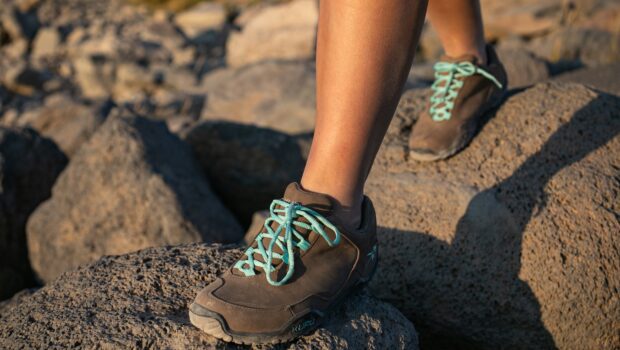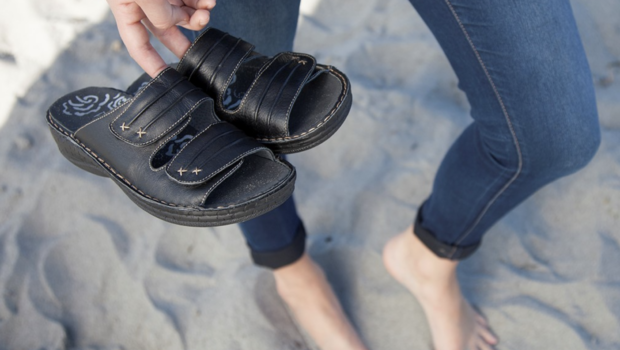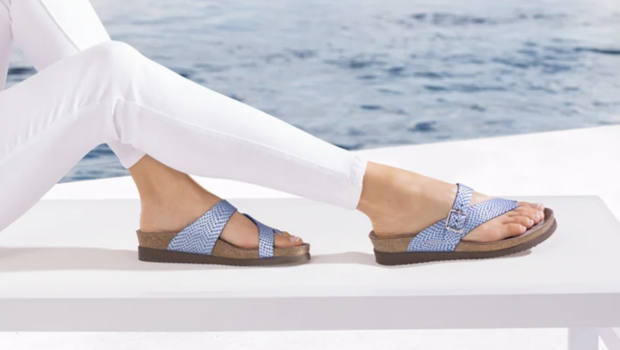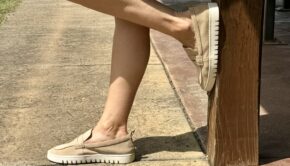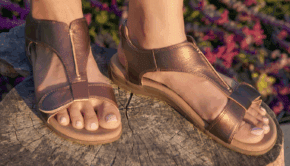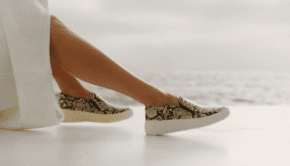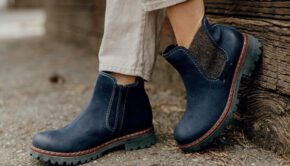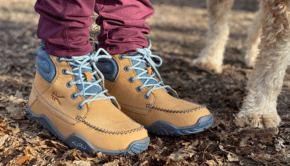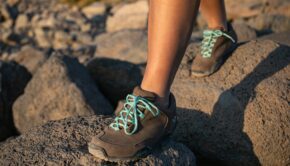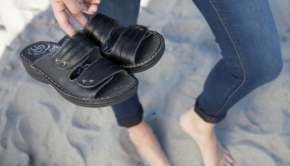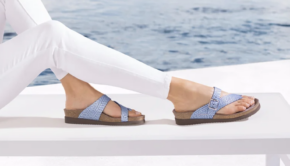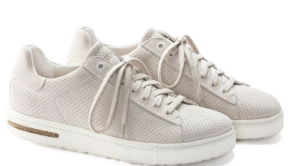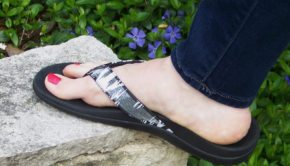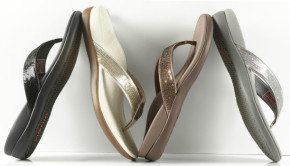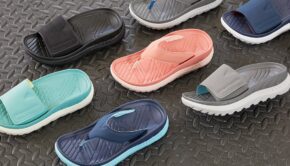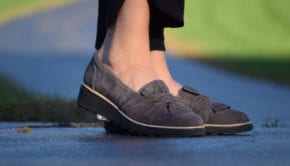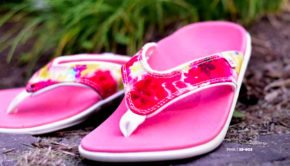

Vionic Uptown Loafer: Arch Support in a Low Profile Loafer!
May 11th, 2025 | by Kirsten Borrink
The Vionic Uptown loafer has been on my radar for a few months. I asked the Barking Dog Shoes Facebook
Reader Request: 5 Plantar Fasciitis Sandals with Style and Support
April 18th, 2025 | by Kirsten Borrink
Plantar Faciitis sandals – which are the best? See Kirsten’s recommendations to a reader’s request… Hello, Kirsten! I have been
Best Shoes for Plantar Fasciitis [6 Stylish Options for Women]
January 30th, 2025 | by Kirsten Borrink
Every few months, we investigate the best plantar fasciitis shoes for women–always keeping fashion in mind. As we can’t road
8 Cute, Comfortable Ankle Boots Bring Blissful Relief to Problem Feet
December 6th, 2024 | by Kirsten Borrink
Ankle boots have established themselves as a wardrobe staple deserving of top-shelf status right next to tall boots. In fact,
Kuru Quest Hiking Boots : Kirsten’s Review
November 1st, 2024 | by Kirsten Borrink
This review of the Kuru Quest hiking boots is sponsored by Kuru Footwear. The opinions are completely my own based
Kuru Shoes Review [2024 Models] Chicane Supportive Trail Hiker
August 30th, 2024 | by Kirsten Borrink
I’m thinking of a four letter shoe brand that starts with “K.” They make ultra-comfortable active footwear. Up until a
5 Stylish Orthotic Friendly Sandals with Removable Footbeds
August 19th, 2024 | by Kirsten Borrink
Are you tired of wearing sneakers and closed-toe shoes all summer long just because you must wear doctor-prescribed orthotics?We hear
Mephisto Helen Sandal Review : Incredible Arch Support in a Stylish Sandal
July 22nd, 2024 | by Kirsten Borrink
The lovely Mephisto Helen sandal comes back year after year in new colors, textures and patterns. Its classic style and
Birkenstock Bend Review: The Good For You Sneaker
July 10th, 2024 | by Kirsten Borrink
The incredible Birkenstock Bend sneaker is the magic bullet for alleviating discomfort from foot maladies such as plantar fasciitis, over-pronation,
Vionic Tide Review: Stylish Flip-Flop with Arch Support
June 1st, 2024 | by Kirsten Borrink
Anne G. reviews the Vionic Tide sandal I am a very active woman in her early 50’s. I can often spend
Vionic Tide Sequins Review
July 2nd, 2023 | by Kirsten Borrink
I remember visiting friends in Little Rock, Arkansas last summer and noticing many women in sparkly flip-flops. Tweens, teens, their
Vionic Sandals Offer Enhanced Arch Support – See Our Top Picks!
March 18th, 2023 | by Kirsten Borrink
No matter your style aesthetic, there is a pair of Vionic sandals for you! Heralded for their terrific support and
Clark’s Sharon Dasher Review: You’ll Love this Lightweight Loafer
August 24th, 2022 | by Kirsten Borrink
(The Clark’s Sharon Dasher is no longer available but all links in article lead to Clarks loafers that are similar
Spenco Sandals – Total Support, Lightweight Yumi Sandal
July 25th, 2022 | by Kirsten Borrink
Spenco Sandals You’ve heard of Spenco insoles, but did you know they make supportive sandals designed to alleviate foot problems
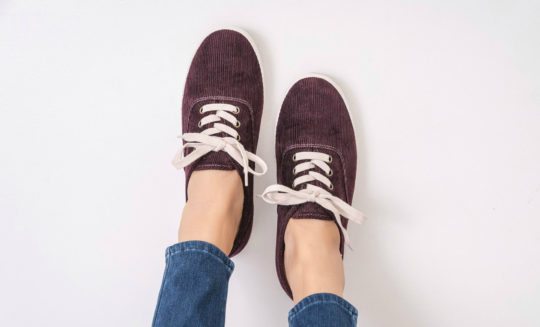 What is Plantar Fasciitis?
What is Plantar Fasciitis?
Your foot is a complicated mechanism. The bottom of your foot is known as the plantar side. The plantar fascia is a long band of thick connective tissue that runs along the bottom of your foot. It connects your heel bone to your toe bones, creating the arch in your foot. It stretches and flexes when your foot bears weight to support the arch and take away some of the impact on the rest of the middle of your foot. This part of your foot also works in something called the windlass mechanism. Basically when your big toe flexes as you step or prepare to step, the plantar fascia winds tighter. This supports your arch and tightens up your foot to help propel you forward. But sometimes a problem develops and the plantar fascia develops small tears.

Image from www.firstaidforfree.com
Mayo Clinic describes the plantar fascia as a “shock-absorbing bow string, supporting the arch in your foot. Put too much tension on that bow string and this thick rubber band-like tissue develops small tears.” Basically a fancy way of saying your heels really hurt from tiny scarring in your tissue. Chicago Bulls player Joakim Noah, a PF suffered, described it as “needles under your feet.” Over time the pain can become worse and worse.
Cause of Plantar Fasciitis
Normally the body repairs small tears in tissue or muscles. For instance typical muscle strengthening exercises actually create tiny tears in your muscles by overworking them. Overnight or during rest, your body repairs the tears, leading to stronger muscles. But in cases of plantar fasciitis, experts think the tiny tears in your fascia don’t heal. You develop more and more of tears, leading to more and more pain. Interestingly, the medical community used to think plantar fasciitis was just inflamed tissue. The ‘-itis’ in fasciitis means inflammation. But experts looked at some biopsies from plantar fasciitis feet, they didn’t find any of the body’s normal markers for inflammation. So now its more fully understood to originate in the tiny pesky tears in tissue.
Why is it so bad in the morning? The fascia also tightens when you sleep. That’s why it is so darn painful when you take the first steps in the morning or walk after prolonged periods of sitting if you have plantar fasciitis. Your body has to stretch and warm up the fascia before the pain gets a little better.
Some people are just at higher risk of plantar fasciitis. Some of the factors include:
- Flat feet (low arches)
- High arches
- Obesity
- Age (being over 40, ugh!)
- Tight Achilles tendon
- Excessive pronation (rolling inward when you walk or run)
- Overuse injury from sports. The NY times reports that plantar fasciitis takes out up to 10% of all runners
Another contributing factor to plantar fasciitis is wearing improper shoes. For instance, those inexpensive summer flip flops may not offer enough support for some feet. They could lead to strains in your arches and heel. Particularly flip flops that require a lot of effort from your toes to keep them from slipping off your feet as you walk.

Flimsy flip flops may be popular but they can also contribute to the heel pain known as plantar fasciitis. Our blog has some great flip flops that support your feet.
For me I notice plantar fasciitis in the spring after a winter of walking around my hard floors with no shoes or non-supportive shoes. We hear from many women that get this heel pain after a winter of indoor no shoe visits at their home or other places. Doctors also say they see the condition in people who wear unsupportive shoes in jobs that require them to be on their feet on hard surfaces for much of the day.
Symptoms of Plantar Fasciitis
- Heel pain.
- Swelling
- Tenderness in bottom of feet
- Pain in the arch
- Pain that’s bad in the early morning and subsides (after you stretch out the PF) In the most severe cases people say that typical morning trip to the bathroom may not even seem worth it because they know the shooting pain that’s coming!
Treatment of Plantar Fasciitis
So what if you’ve developed the painful heels common in plantar fasciitis? Experts say there are several things you can do at home to help plantar faciitis.
- Don’t go barefoot : this stresses your plantar fascia. We’ve reviewed many shoes that are comfortable enough to wear around the house!
- Stretches: Stretching exercises, if directed by a doctor or physical therapist, done several times a day are thought to result in less stress on the plantar fascia when exercising, giving your body’s repair “team” more time to catch up on those tiny tears.
- Calf stretching
- Stretching the Achilles tendon which also attaches to the heel bone
- Stretching the planter fascia
We found some helpful examples of stretches to help plantar fasciitis on footcaremd.com, the consumer website run by the American Orthopedic Foot and Ankle Society.
- Rest. And avoiding impact sports
- Ice: literally cooling your heels, with ice packs for 20 minutes, several times a day can help
- Rolling tennis balls or a frozen bottle under foot
- Padding in your shoes such as inserts or orthotics. We’ve got shoes and even boots that allow orthotics.
Another common ‘treatment’ the experts suggest is to change your shoes. (We can help!) According to the American College of Foot and Ankle Surgeons “wearing supportive shoes that have good arch support and a slightly raised heel reduces the stress on the plantar fascia.” That pair of shoes you love but that wore out their support long ago could be giving you a pain in your heel. Those popular flimsy ballet flats you see everywhere are also getting the blame for some of plantar fasciitis cases. But good news there, I’ve reviewed flats, yes the best flats for plantar fasciitis that won’t give anyone the impression of orthopedic shoes. Each shoe featured really doesn’t qualify as a flat. Most podiatrists will recommend at least a half-inch heel to take stress off the fascia. So that’s what I’ve found! They also offer arch support, room in the toes and removable insoles in case you need to add an orthotic.
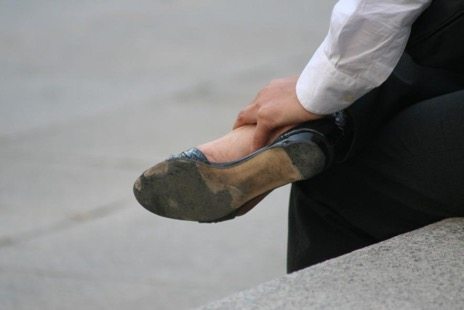
Time for a change? Experts say worn out shoes that have lost their support could contribute to plantar fasciitis.
Experts say you should talk to your doctor if the condition is not improving. Sometimes trying to avoid the pain in your heels can make you walk differently, which can lead to problems in your hips or back later on.
- Medication: Your doctor may recommend non steroidal anti inflammatory medication, or they may do cortisone injections. One study found people with plantar fasciitis who got cortisone injections reported less heel pain after 4 weeks.
- Physical therapy: to get correct stretches or other advice
- If the condition persists, your doctor may want to order x-rays to check for heel spurs and rule out other causes
- A doctor may also suggest a removable walking cast to give yourself time to heal
- Night splint
- Shock wave therapy- a newer treatment that sends energy at your tissues to help healing.
Plantar Fasciitis Shoes
If you know you have plantar fasciitis and you’re looking for comfortable shoes that you can wear to spare your painful heels, we’ve got some great ideas on our blog. Generally experts recommend:
- Avoid flat flimsy shoes that don’t support the feet. A firm sole can help control the foot’s range of motion and help protect it.
- Shoes with a bit of lift in the heel and that cradle the heel and support your arches
- Shoes that don’t pinch your toes.
Why all the talk about rocker sole clogs?
Wearing shoes that reduce movement in your foot can help relieve the pain of plantar fasciitis. Rocker sole shoes are often the ones you hear about for PF. They typically have a stiff, curved bottom that allows your foot to make a rocking movement instead of flexing and extending the toes. Some just have a rounded sole up front by the toes which helps you roll into the step instead of flexing your toes as much. These can be great choices for some women but we know that we girls love our shoes and we want a life beyond rocker clogs!
Shoes for women with plantar fasciitis
We receive so many notes about plantar fasciitis that we’ve done a roundup of styles in several of our blog posts. Check out the many styles in this post which range from heels to ankle boots and flats.
And here are 8 comfortable shoes for plantar fasciitis, some casual, some dressy for special occasions or work.
If you’re a female you probably love to slip on cute shoes in the summer! I do too. I’ve created a whole separate category on the blog devoted to sandals for plantar fasciitis. Here are five stylish sandals for plantar fasciitis that I’m hoping will fit the bill for your feet.
Flip Flops for Plantar Fasciitis
I just can’t wear the non-supportive flip flops you can find all over in the summer. But I’ve found plenty of cute choices in the sandal category that offer support and style. Check out my review of the Spenco Yumi flip flop for instance.
If you’re a Birkenstock fan (supportive, well made), we highlight several cute styles of Birkenstocks.
Flats
Finding flats that aren’t ‘flat’ so those of us with problem feet can wear them is a job I relish! Here are 7 flat shoes with arch support that can be appropriate for plantar fasciitis.
Shoes for colder months
When the temps turn colder, you’ve got choices beyond orthopedic shoes in the fall and winter as well. If you thought that booties weren’t going to work for your plantar fasciitis feet, here’s a post about booties with a built-in orthotic that some readers have loved.
Athletic shoes
Did you know not all tennis shoes are created equal? Some athletic shoes may be better for your foot problems than others. Readers helped me identify several choices that help relieve plantar fasciitis. Check out this write up of a pair a reader got from seeing them on her nurse!
Hiking Boots
And we’ve even looked at hiking boots, including some great ones by Merrel.
We hope this page gives you hope that by spending a few minutes on our blog you may uncover shoes that you not only love wearing but also make it less painful to deal with plantar fasciitis. If you have shoes or boots that you’ve found help with your plantar fasciitis, please share! We also have an active community of readers and tips on our Facebook page.
Related Resources
Footcaremd.com – consumer site of the American Orthopaedic Foot and Ankle Society
Foothealthfacts.org – consumer site of the American college of foot and ankle surgeons
Note: the above content is not intended to be medical advice or substitute for seeking the advice of a qualified medical professional. We’re talking shoes here.

